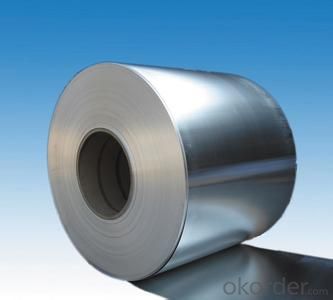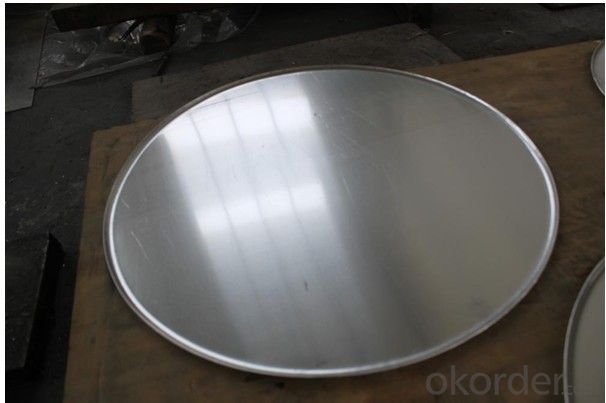Continuous Casting Aluminium Strips for Food Cookware AA1060
- Loading Port:
- Shanghai
- Payment Terms:
- TT OR LC
- Min Order Qty:
- 2 m.t.
- Supply Capability:
- 20000 m.t./month
OKorder Service Pledge
OKorder Financial Service
You Might Also Like
Item specifice
1.Structure of Continuous Casting Aluminium Strips for Food Cookware AA1060
Continuous Casting Aluminium Strips for Food Cookware AA1060 are widly used in decoration field. For the painting, it depends on the using evironment. If you use in the open air, we recommend the PVDF coated aluminium coils. This kind of painting can last 15-20 years. If you use in the room, we recommend PE coated aluminium coils. The price is much more competitive.
2. Main features of Continuous Casting Aluminium Strips for Food Cookware AA1060
a.Competitive price---We have our own mills and can produce mill finished aluminium coils, so we can control the production cost better.
b.Professional after-sale service---We have more than 15 years exportation experience and you need not worry about the exporation problems.
c.Fast delivery time---We can control the delivery time within 35 days.
3. Image of Continuous Casting Aluminium Strips for Food Cookware AA1060



4. Product Specification of Continuous Casting Aluminium Strips for Food Cookware AA1060
| Alloy | Temper | Rolling | Thickness | Width |
| AA1060 | F | Hot Rolled | 0.2MM-2MM | 1000MM-1500MM |
5.FAQ of Continuous Casting Aluminium Strips for Food Cookware AA1060
What is the quality standard?
---Usually our standard is GB3880-2006
What is the largest width?
---It is 2300mm
What is the MOQ?
---Usually we can accept 80 tons.
- Q:What kind of welding rod should be used for aluminum plate, welding and welding?.
- Aluminum plate welding, if it does not take into account the deformation or the objective conditions of the gas, it is recommended to use AC aluminum arc welding machine welding, welding is also commonly used.If considering the deformation and welding method is more simple words, can be used in low temperature aluminum WE53 solid aluminum wire flame welding, the welding is more suitable for super thin aluminum sheet, the thinner the better welding.If it is in the plate, and no argon arc welding machine or manual, you can use the aluminum welding wire welding, aluminum welding wire welding using WEWELDING 555 aluminum electrode welding imports, there is a reference video you can go to see "the use of WE555 aluminum welding wire welding in the Aluminum Alloy"Do not understand, you can continue to ask
- Q:What is the cost of aluminum sheet compared to other metals?
- The price of aluminum sheet can differ from other metals depending on various factors like market conditions, availability, and specific metal grades. Generally, aluminum sheet is considered more economical than stainless steel, copper, and brass, among others. This is primarily because aluminum is abundant in the Earth's crust and the extraction and refining processes are relatively inexpensive. In addition, aluminum is often lighter in weight compared to other metals, making it a cost-effective choice for industries where weight is a concern, such as transportation. However, it should be noted that the cost of aluminum can change due to global supply and demand, tariffs, and other economic factors. Therefore, it is advisable to check current market prices and consult with suppliers or metal experts for accurate and up-to-date pricing information.
- Q:Are aluminum sheets suitable for decorative paneling?
- Yes, aluminum sheets are suitable for decorative paneling. Aluminum is a versatile material that offers a range of benefits for decorative applications. Firstly, aluminum sheets are lightweight, making them easy to handle and install. This makes them a practical choice for both interior and exterior paneling. In addition to being lightweight, aluminum sheets are also durable and corrosion-resistant. They can withstand various weather conditions, including humidity and UV exposure, without losing their appearance or structural integrity. This durability ensures that the decorative paneling will maintain its aesthetic appeal over time, even in high-traffic areas. Furthermore, aluminum sheets provide a sleek and modern look to any space. They can be easily customized through various finishes, such as brushed, polished, or anodized, allowing for endless design possibilities. The reflective properties of aluminum can also enhance the overall appearance of a room by creating an illusion of more space and light. Moreover, aluminum is a sustainable material, as it is fully recyclable without compromising its quality. This makes it an environmentally friendly choice for decorative paneling, aligning with the growing trend towards sustainable design. Overall, aluminum sheets are an excellent option for decorative paneling due to their lightweight nature, durability, versatility in design options, and sustainable properties. Whether for residential or commercial purposes, aluminum paneling can add a modern and visually appealing touch to any space.
- Q:If I were to make an aluminum mold and cover it with a release agent, could I cast aluminum into it? Or would the two parts fuse together? I'm trying to find an alternative to sand casting.Thank you!
- This may be a little more difficult but offers better detail than sand casting. Lost wax casting Investment or ceramic shell You can make molds to form the wax but investment or ceramic shell are destroyed in the process
- Q:What are the different thicknesses available for aluminum sheet?
- The different thicknesses available for aluminum sheet vary depending on the specific requirements and applications. Common thicknesses for aluminum sheet range from 0.016 inches (0.41 mm) to 0.25 inches (6.35 mm), with numerous options in between. The appropriate thickness is determined by factors such as the intended use, structural requirements, and aesthetic preferences.
- Q:When water continually sprays on the aluminum sheet, how to avoid corrosion of aluminum sheet and keep its water resistance?
- Don’t worry about it, after aluminum contacts water or air, a layer of oxide film will generate on its surface to separate aluminum from the water or air and protect it, so it won’t be erosive.
- Q:Are the aluminum sheets suitable for automotive applications?
- Indeed, automotive applications can make use of aluminum sheets. Being a lightweight material with a high strength-to-weight ratio, aluminum proves to be an excellent choice for the automotive industry. Its attributes lend themselves well to this industry, offering numerous benefits such as enhanced fuel efficiency, improved handling, and increased performance. Furthermore, aluminum's resistance to corrosion is advantageous for automotive applications, as it contributes to the longevity of vehicles. Furthermore, aluminum sheets possess the ability to be easily shaped and molded into various forms, which grants automotive manufacturing greater design flexibility. In conclusion, the utilization of aluminum sheets in automotive applications has gained popularity due to their myriad advantages and their positive impact on vehicle performance and sustainability.
- Q:Can aluminum plate protect against radiation?
- First, the installation depends on the way, the direct aluminum plate can not, the aluminum plate must be grounded in order to play a role. The ground is connected with the earth plate, this shot to the electromagnetic wave on the aluminum plate will be aluminum absorption into electrical energy and flow to the ground, if not grounded on the other side will generate an electric field in aluminum, is directly through to the. In fact, grounding is very simple, if the installation of the use of metal screws directly contact the aluminum plate, but also with the cement wall contact, you can be grounded, although not good grounding. If the wall is a wooden board and so on, the insulating material can not, and then there is a screw, if it is used in the wall dug into the plastic sleeve also can not, because the plastic will be insulated.
- Q:Are aluminum sheets resistant to saltwater corrosion?
- Yes, aluminum sheets are generally resistant to saltwater corrosion. Aluminum has a natural ability to form a protective oxide layer when exposed to air or water, including saltwater. This oxide layer acts as a barrier, preventing further corrosion and protecting the underlying metal. Additionally, aluminum is lightweight and durable, making it a popular choice for various marine applications such as boats, shipbuilding, and offshore structures. However, it is important to note that the resistance to saltwater corrosion can vary depending on the specific alloy and surface treatment of the aluminum sheets. Therefore, proper selection of the appropriate alloy and protective coatings can further enhance the corrosion resistance of aluminum sheets in saltwater environments.
- Q:What are the different methods of surface etching for aluminum sheets?
- There are several methods of surface etching for aluminum sheets, each with its own advantages and applications. Some of the most common methods include: 1. Chemical etching: This method involves using a chemical solution to selectively remove a thin layer of aluminum from the surface. The solution typically contains acids or alkaline substances that dissolve the metal, creating a textured or patterned surface. Chemical etching is precise and can achieve intricate designs, making it ideal for decorative or aesthetic purposes. 2. Mechanical etching: Also known as abrasive blasting or sanding, mechanical etching involves using abrasive materials such as sandpaper or wire brushes to physically remove the top layer of aluminum. This method is relatively simple and can be done manually or with the help of machinery. Mechanical etching is commonly used to create a uniform matte finish or to prepare the surface for further treatments, such as painting or coating. 3. Electrochemical etching: This method utilizes an electrical current to selectively dissolve the aluminum surface. The aluminum sheet is immersed in an electrolyte solution, and a direct current is applied through a stencil or mask to create the desired pattern. Electrochemical etching is commonly used for marking or labeling purposes on aluminum sheets, as it can produce clear, permanent, and highly precise designs. 4. Laser etching: Laser etching involves using a high-powered laser to remove the top layer of aluminum, creating a permanent and precise pattern on the surface. This method is highly accurate and can achieve intricate designs with sharp edges. Laser etching is commonly used for industrial applications, such as marking serial numbers, logos, or barcodes on aluminum sheets. 5. Photochemical etching: This method involves using a photosensitive material, known as a photoresist, to create a pattern on the aluminum surface. The aluminum sheet is coated with the photoresist, exposed to UV light through a stencil or mask, and then developed to remove the unexposed areas. The exposed aluminum is then etched away using a chemical solution. Photochemical etching is commonly used for producing high-resolution designs or microstructures on aluminum sheets. Each of these methods has its own advantages, depending on the desired outcome and application. It is important to consider factors such as precision, speed, cost, and complexity when choosing the appropriate surface etching method for aluminum sheets.
1. Manufacturer Overview |
|
|---|---|
| Location | |
| Year Established | |
| Annual Output Value | |
| Main Markets | |
| Company Certifications | |
2. Manufacturer Certificates |
|
|---|---|
| a) Certification Name | |
| Range | |
| Reference | |
| Validity Period | |
3. Manufacturer Capability |
|
|---|---|
| a)Trade Capacity | |
| Nearest Port | |
| Export Percentage | |
| No.of Employees in Trade Department | |
| Language Spoken: | |
| b)Factory Information | |
| Factory Size: | |
| No. of Production Lines | |
| Contract Manufacturing | |
| Product Price Range | |
Send your message to us
Continuous Casting Aluminium Strips for Food Cookware AA1060
- Loading Port:
- Shanghai
- Payment Terms:
- TT OR LC
- Min Order Qty:
- 2 m.t.
- Supply Capability:
- 20000 m.t./month
OKorder Service Pledge
OKorder Financial Service
Similar products
New products
Hot products
Related keywords





























